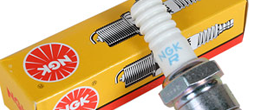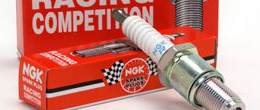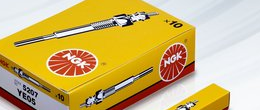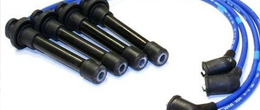

1) Carbon fouling
If the air and gasoline mixture is rich (i.e., it contains a higher proportion of gasoline), carbon will be produced by incomplete combustion. If this carbon accumulates on the firing end of the plug, the insulator resistance between the center electrode and the metal shell will be reduced and this may cause misfiring. See Photo 1.
In cold regions (or in winter), because the external air temperature is low, the gasoline does not form a fine mist and therefore does not mix well with the air. Entry of gasoline in liquid form into the combustion chamber leads to incomplete combustion and makes it easier for carbon to form. There is hardly any carbon generation in vehicles that use a gas fuel, LPG or CNG, like taxis for example.
Wet fouling is seen, for example, in motorcycles (with two-stroke engines). With oil and gasoline covering the carbon that has adhered to the firing end, the insulation resistance value drops abruptly, causing misfires. See Photo 2.

2) The causes of carbon fouling are:
- Causes relating to the fuel system
- Carburettor maintenance fault
- Injector fault
- Oxygen sensor fault (sensor fault)
- Clogging of the air cleaner element, etc.
- Causes relating to the ignition system
- Delay in the ignition timing
- Plug heat range is too high

3) Insulation resistance
A high voltage is applied to the center electrode but if there is carbon adhering to the firing end of the plug the insulation resistance is lowered and spark leakage occurs, so this voltage does not result in a spark across the spark gap.
Normally, when there is no adhering carbon, the insulation resistance is an infinite value but when there is adhering carbon and the insulation resistance reaches around 10 MΩ or less spark leakage occurs and no spark can be produced across the spark gap. Naturally this means the engine will not start.
4) The cause of carbon fouling lies in the fuel system. It is not a problem with the plug.
If the carbon adhering to the plug is cleaned off (by sandblasting), the function of the plug will be recovered and it will be possible to re-use it. However, few motor maintenance or repair facilities have such a plug cleaner installed, so our recommendation is to change the plug if possible.
Note: If dry fouling occurs at only one of the cylinders there is the possibility that the problem is caused by the plug. (For example, while fitting a plug the wrench can slip and damage the core of the insulation although this is not detectable from the external appearance, and spark leakage may occur as the result of this damage.)





